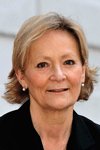Day 2 :
Keynote Forum
Barbara Koch
Albert-Ludwigs University of Freiburg , Germany
Keynote: New perspectives of combined data sets for environmental information
Time : 09:05-09:30

Biography:
Professor Dr. Barbara Koch studied Forest Sciences from 1977 to 1982 at the Ludwig-Maximilians University in Munich. From 1982 to 1994 she worked as a scientific staff member at the Institute of Land Use Planning and Nature Conservation at the Technical University of Munich (Ludwig-Maximilians University in Munich). Today Ms Koch holds the chair of Remote Sensing and Landscape Information Systems at the Albert-Ludwigs University of Freiburg. She has worked in numerous research projects on remote sensing and geo-modelling in the frame of forest and landscape analyses. At this time, she is Academic Dean of the Faculty of Environment and Natural Resources, board member of the Centre for Renewable Energy, Head of the working group on Education of the University Centre for Sustainability and Transformation and Vice-Chairwoman of the Senate commission.
Abstract:
For environmental information it is of importance to link data from terrestrial measurements with remote sensing. Often vast terrestrial data sets exist as point data however for environmental studies area coverage is needed. In addition often different data sets need to be fused or connected to produce new information layers. Today a suite of remote sensing data is available connecting through different scales and providing different data properties which is complementary for more adjusted information. This talk will describe new developments and provide examples how the combination of satellite remote sensing data linked to terrestrial data will enhance the information value. The examples will refer to information provision in the field of renewable energy but also include examples for biodiversity studies, biomass studies and information for landscape analyses.
Keynote Forum
Oyvind G Gron
Oslo and Akershus University, Norway
Keynote: Celebrating the centenary of the Schwarzschild solutions and Einstein’s prediction of gravitational waves and their detection by LIGO
Time : 09:30-09:55

Biography:
Oyvind G Gron is a Norwegian Physicist. He took the Cand. Real. Degree at the University of Oslo in 1973, majoring in Meteorology. He followed up with Dr. Philos. Degree in 1990 with a thesis on Repulsive Gravitation. He was appointed as a Professor at Oslo University College in 1994. He has also been Professor II at the University of Oslo since 1994. He has conducted research within the areas of general relativity, cosmology and classical electromagnetism. He has thrown new light on themes like the twin paradox, the physics in a rotating reference system and repulsive gravitation associated with vacuum energy. Together with Erik Eriksen at the University of Oslo, he has also studied properties of the electromagnetic field produced by accelerated electric charges. They have in particular shown how gravitation modifies such fields. He has also found new solutions to equations in Einstein's theory of gravity that describe time space where one can travel backwards in time. In several studies, he has focused on relativistic models of the universe. He has, among other things, shown that it is possible to interpret observations from cosmos so that the concept of dark energy is unnecessary. The relationship between gravitation and time and between gravitation and entropy are also themes where he has contributed several journal articles. He has 153 research articles, and has written 3 books on the theory of relativity published by Springer.
Abstract:
Schwarzschild presented his exterior and interior solutions a hundred years ago. They describe spacetime outside and inside an incompressible, spherically symmetric body. I give a review of these solutions and how they have been interpreted physically. Einstein predicted the existence of gravitational waves as a consequence of the general theory of relativity in June 1916. I briefly follow his thoughts about gravitational waves in the periods from 1016 to 1918 and from 1936 to 1938. The LIGO-detection of gravitational waves is reviewed. Consequences of this detection as investigated in later preprints are also discussed
Keynote Forum
Stanislav I Klimov
Russian Academy of Sciences (IKI RAS), Russia
Keynote: History and modernity of the study of Space Weather in Russia
Time : 09:55-10:20

Biography:
Stanislav I Klimov Born on 27 June 1937 in Tula region, Russia. He is Head of Laboratory for Electro - Magnetic Emissions Investigation, Department of Space Plasma Physics, Space Research Institute (IKI), Russian Academy of Sciences. S. Klimov graduated from Department of Physics, Moscow State University (1966), received Ph.D. of physics-mathematics in 1984, Doctor of Sciences of physics-mathematics in 1994. Now he is the Scientific Manager of ASPI experiment INTERBALL TAIL PROBE and APW-R Relict-2 wave and field experiments and WEC Cluster wave experiment Co-I. The laboratory he leads also includes the electrostatic and magnetic cleanliness and EMC group. Now this group uses the experience from the previous projects for the study of the electro-magnetic environment of the MIR orbital station and in the future experiments of the International Space Station. He has more than 100 publications. His research interest includes: Waves in solar wind /magnetospheres and comet plasma interactions, magnetospheric convection and magnetosphere-ionosphere coupling, interaction of the supper large bodies (orbital station) with ionosphere.
Abstract:
The so called “simplest satellite” (or PS object) was launched on October 4, 1957. It was followed by the second spacecraft that for the first time brought a living creature, Laika the dog, into space on November 3, 1957. Officially both launches were dedicated to the International Geophysical Year: July 1 1957 – December 31, 1958. And only then it was the turn of the satellite, which had originally had to be the first. Dubbed “The Third Sputnik”, it was already a full-fledged spacecraft sporting all the systems inherent to modern ones. For the first time onboard devices received and executed commands sent from the ground. Instruments built by seven different groups of Soviet scientists operated onboard the satellite. Research results were downlinked to the Earth.
